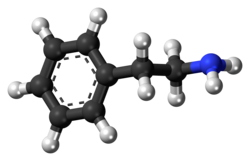펜에틸아민
펜에틸아민(Phenethylamine,PEA) 또는 페네틸아민은 실온에서 무색 액체인 방향성 아민족 물질이다. 페네틸아민 또는 더 적절하게는 치환된 페네틸아민(Substituted phenethylamines)은 페네틸아민을 백본(backbone)으로 포함하는 페네틸아민 유도체 그룹이다. 다시 말해서, 이 화학 부류는 페네틸아민 코어(core) 구조에서 하나 이상의 수소 원자를 치환기로 대체하여 형성된 유도체 화합물을 포함한다. 치환된 페네틸아민 부류에는 모든 치환된 암페타민 및 치환된 메틸렌디옥시펜에틸아민(MDxx,methylenedioxyphenethylamines 또는 Substituted methylenedioxy- phenethylamines)이 포함되며, 특히 공감, 각성, 환각, 식욕 부진, 기관지 확장, 충혈 완화 및 또는 항우울에 관여하여 작용하는 많은 메커니즘에서의 생화학 반응을 포함한다.

| |

| |
| 체계적 명칭 (IUPAC 명명법) | |
|---|---|
| 2-Phenylethan-1-amine | |
| 식별 정보 | |
| CAS 등록번호 | 64-04-0 |
| ATC 코드 | none |
| PubChem | 1001 |
| 드러그뱅크 | DB04325 |
| ChemSpider | 13856352 |
| 화학적 성질 | |
| 화학식 | C8H11N |
| 분자량 | 121.18 g/mol |
| SMILES | eMolecules & PubChem |
| 유의어 | PEA; phenylethylamine |
| 물리적 성질 | |
| 밀도 | 0.9640 g/cm³ |
| 녹는점 | -60 °C (-76 °F) [1] |
| 끓는점 | 195 °C (383 °F) [1] |
| 약동학 정보 | |
| 생체적합성 | ? |
| 동등생물의약품 | ? |
| 약물 대사 | Primarily: MAO-B[2][3][4] Other enzymes: MAO-A,[4][5] SSAOs (AOC2 & AOC3),[4][6] PNMT,[2][3][4] AANAT,[4] FMO3,[7][8] and others |
| 생물학적 반감기 | |
| 배출 | Renal (kidneys) |
| 처방 주의사항 | |
| 임부투여안전성 | ? |
| 법적 상태 |
|
| 중독 경향 | Psychological: low–moderate Physical: none |
| 투여 방법 | Oral (taken by mouth) |
치환된 페네틸아민
편집주요한 치환된 페네틸아민들로는 도파민(3,4-dihydroxyphenethylamine), 에피네프린(β,3,4-trihydroxy-N-methylphenethylamine), 노르에피네프린(β,3,4-trihydroxyphenethylamine), N,N-디메틸페네필아민(N,N-Dimethylphenethylamine 또는 N,N-DMPEA), 메스암페타민(methamphetamine, methylamphetamine, desoxyephedrine), MDMA(3,4-Methylenedioxymethamphetamine)등 다수가 있다.
같이 보기
편집각주
편집- ↑ 가 나 〈Chemical and Physical Properties〉. 《Phenethylamine》. 《PubChem Compound》. United States National Library of Medicine – National Center for Biotechnology Information.
- ↑ 가 나 다 Lindemann L, Hoener MC (2005). “A renaissance in trace amines inspired by a novel GPCR family”. 《Trends Pharmacol. Sci.》 26 (5): 274–281. doi:10.1016/j.tips.2005.03.007. PMID 15860375.
The pharmacology of TAs might also contribute to a molecular understanding of the well-recognized antidepressant effect of physical exercise [51]. In addition to the various beneficial effects for brain function mainly attributed to an upregulation of peptide growth factors [52,53], exercise induces a rapidly enhanced excretion of the main β-PEA metabolite β-phenylacetic acid (b-PAA) by on average 77%, compared with resting control subjects [54], which mirrors increased β-PEA synthesis in view of its limited endogenous pool half-life of ~30 s [18,55].
- ↑ 가 나 Broadley KJ (March 2010). “The vascular effects of trace amines and amphetamines”. 《Pharmacol. Ther.》 125 (3): 363–375. doi:10.1016/j.pharmthera.2009.11.005. PMID 19948186.
Trace amines are metabolized in the mammalian body via monoamine oxidase
- ↑ 가 나 다 라 마 〈Phenylethylamine〉. 《HMDB Version 3.6》. Human Metabolome Database. 2016년 2월 11일. 2016년 9월 20일에 확인함.
- ↑ Suzuki O, Katsumata Y, Oya M (1981). “Oxidation of beta-phenylethylamine by both types of monoamine oxidase: examination of enzymes in brain and liver mitochondria of eight species”. 《J. Neurochem.》 36 (3): 1298–301. doi:10.1111/j.1471-4159.1981.tb01734.x. PMID 7205271.
- ↑ Kaitaniemi, S; Elovaara, H; Grön, K; Kidron, H; Liukkonen, J; Salminen, T; Salmi, M; Jalkanen, S; Elima, K (2009). “The unique substrate specificity of human AOC2, a semicarbazide-sensitive amine oxidase”. 《Cell. Mol. Life Sci.》 66 (16): 2743–57. doi:10.1007/s00018-009-0076-5. PMID 19588076.
The preferred in vitro substrates of AOC2 were found to be 2-phenylethylamine, tryptamine and p-tyramine instead of methylamine and benzylamine, the favored substrates of AOC3.
- ↑ Krueger SK, Williams DE; Williams (June 2005). “Mammalian flavin-containing monooxygenases: structure/function, genetic polymorphisms and role in drug metabolism”. 《Pharmacol. Ther.》 106 (3): 357–387. doi:10.1016/j.pharmthera.2005.01.001. PMC 1828602. PMID 15922018.
The biogenic amines, phenethylamine and tyramine, are N-oxygenated by FMO to produce the N-hydroxy metabolite, followed by a rapid second oxygenation to produce the trans-oximes (Lin & Cashman, 1997a, 1997b). This stereoselective N-oxygenation to the trans-oxime is also seen in the FMO-dependent N-oxygenation of amphetamine (Cashman et al., 1999) ... Interestingly, FMO2, which very efficiently N-oxygenates N-dodecylamine, is a poor catalyst of phenethylamine N-oxygenation. The most efficient human FMO in phenethylamine N-oxygenation is FMO3, the major FMO present in adult human liver; the Km is between 90 and 200 μM (Lin & Cashman, 1997b).
- ↑ Robinson-Cohen C, Newitt R, Shen DD, Rettie AE, Kestenbaum BR, Himmelfarb J, Yeung CK (August 2016). “Association of FMO3 Variants and Trimethylamine N-Oxide Concentration, Disease Progression, and Mortality in CKD Patients”. 《PLoS ONE》 11 (8): e0161074. doi:10.1371/journal.pone.0161074. PMC 4981377. PMID 27513517.
TMAO is generated from trimethylamine (TMA) via metabolism by hepatic flavin-containing monooxygenase isoform 3 (FMO3). ... FMO3 catalyzes the oxidation of catecholamine or catecholamine-releasing vasopressors, including tyramine, phenylethylamine, adrenaline, and noradrenaline [32, 33].
- ↑ 〈Pharmacology and Biochemistry〉. 《Phenethylamine》. 《PubChem Compound》. United States National Library of Medicine – National Center for Biotechnology Information.
Plasma Pharmacokinetics of PEA Could Be Described By 1st-Order Kinetics With Estimated T/2 of Approx 5-10 Min.
참고 문헌
편집- [참고] (페네틸아민 유도체의 구조적 특성에 관한 이론적 연구 Theoretical Study on Structural Properties of Phenthylamine Derivatives ,국제문화기술진흥원 , The Journal of the Convergence on Culture Technology (JCCT) KCI 등재 Vol.6 No.4 (2020.11) pp.761-766 이철재 URL) https://www.earticle.net/Article/A386414